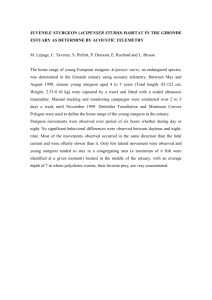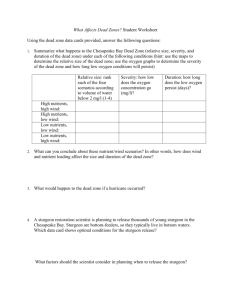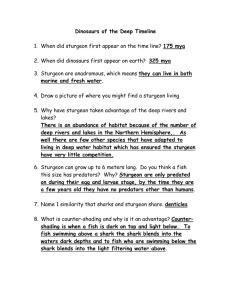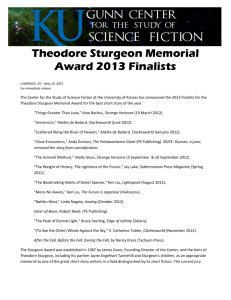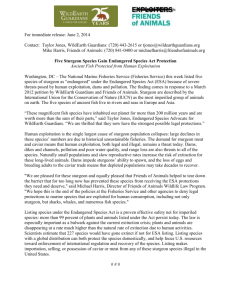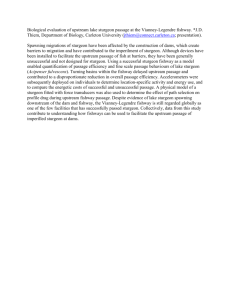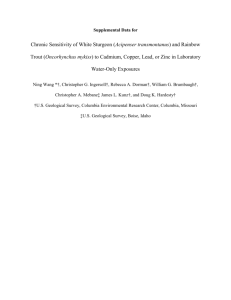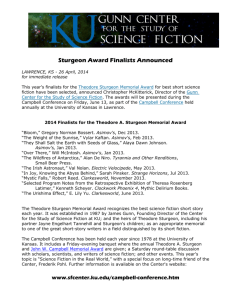Gulf Sturgeon Jessica L. Quintana Acipenser oxyrinchus
advertisement
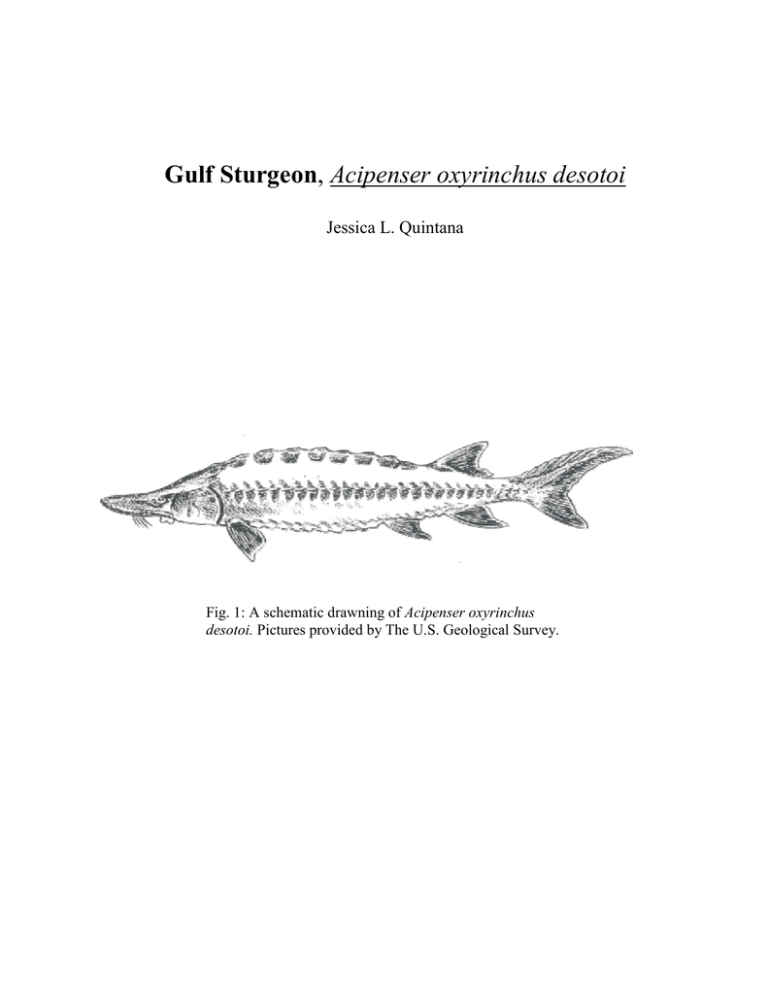
Gulf Sturgeon, Acipenser oxyrinchus desotoi Jessica L. Quintana Fig. 1: A schematic drawning of Acipenser oxyrinchus desotoi. Pictures provided by The U.S. Geological Survey. Abstract The Gulf sturgeon, Acipenser oxyrinchus desotoi, is one of two subspecies of the Atlantic Sturgeon, Acipenser oxyrinchus, with a native range from the West coast of Florida to the Mississippi River Basin in the Gulf of Mexico. Characteristic long snout, sucker mouths, and hard dorsal scutes make the sturgeon an easily recognized fish. It is an anadromous fish using fresh river water for spawning ground. However, their late maturation and the fact that spawning does not occur every year have moved this species to be listed as Threatened by the US Fish and Wildlife Service and Endangered in Mississippi (Ross 2001). Content and Context Class Actinopterygii, Order Acipenseriformes, Family Acipenseridae, Genus Acipenser, species oxyrinchus, subspecies desotoi. The species oxyrinchus refers to pointed snout (Ross 2001). V.D. Vladykov (1955) and than validated in 1985 by C.M. Wooley, confirmed there are two subspecies, a northern species, A.o. oxyrinchus and a southern, gulf species, A. o. desotoi (U.S. Fish and Widlife Serivce 1995). General Characteristics A.o. desotoi is commonly referred to as the Gulf Sturgeon or the Gulf of Mexico Sturgeon. It is an anadromous species with a sub-cylindrical body that posses 5 rows of bony plates, or scutes. The snout is long and cylindrical, or blade-like. On the ventral side of the snout are four barbels that are located antieror to an inferior protrusible mouth that. The protrusible mouth functions in ground feeding due to their benthic feeding habits. Gulf sturgeons tend to be light brown to darker brown in color and almost white on the underside. The dorsal scutes have a lighter colored spot on the tip (USFWS and GSMFL 1995). The Gulf Sturgeon has a characteristic heterocercal tail, with the upper lobe extending further than the lower lobe, as shown in figure 1. Adult sturgeon can range from 1.2-2.4 meters in total length, with the female typically being the larger sex (USFWS and GSMFL 1995). Average weight of sturgeon is around 90.7 kg. Sturgeon can live to be up to 60 years old, however, average life span is around 20 years (NOAA 2013). Historical accounts have recognized Gulf Sturgeon being caught with a total length of 14 feet and up to 600 pounds (Ross 2001). Gulf Sturgeon have characteristic wider and more square like dorsal scutes (Wooley 1985). Distribution A .o. desotoi are most commonly found in major river systems from The Mississippi river to the east Coast of Florida near the Suwannee River (Figure 2). Accounts have been made of Gulf Sturgeon being present as far south as Tampa Bay, Florida (U.S. Fish and Wildlife Service 1995). In Mississippi, Gulf Sturgeons are prominent in the Pascagoula, Pearl, and Mississippi Rivers and their associated drainages. (Ross 2001). Fig. 2: The home range, both offshore and inshore of A.o. desotoi. Map provided by the National Oceanic and Atmospheric Administration, 2013. Form and Function The class Actinopterygii refers to extant primitive ray finned fishes. The Order Acipenseriformes refers to a group of primitive ray-finned fishes that include sturgeon and paddlefish. The family Acipenseridae includes 25 species of sturgeons, all of which are native to the Northern Hemisphere. The family is distinct by their large, elongate snouts and protrusible mouths that include four ventral barbells, and a mostly cartilaginous skeleton (Helfman 2009). The species, Acipenser oxyrinchus refers to the Atlantic Sturgeon which includes two subspecies, the Atlantic Coast sturgeon, Acipenser oxyrinchus oxyrinchus and the Gulf of Mexico Sturgeon, or simply Gulf Sturgeon, Acipenser oxyrinchus deotoi. The Gulf Sturgeon’s subspecies name comes from the sixteenth century explorer, Hernando de Soto, who explored the Gulf Of Mexico coast. Wooley (1984) reevaluated a study completed by Vladykov (1955) that looked at morphometric characteristics that can be used to differentiate the two subspecies. Despite native home ranges of the two Atlantic sturgeon subspecies, Wooley (1984) found that location was not enough to define them as subspecies. His studied investigated numerous measurements such as dorsal scute shape, pectoral fin length, and head size and found that there were significant differences between the two subspecies, however due to the degree of overlap in values, confirmation of subspecies was not determined. The only morphometric characteristic that provided enough statistical support to differentiate the two subspecies was spleen length. The A.o. desotoi had almost double the percentage of mean spleen length versus fork length as compared to A.o. oxyrinchus. That information alone was enough to completely validate the presence of two subspecies of the Atlantic Sturgeon, Acipenser oxyrinchus. Ontogeny and Reproduction Gulf Sturgeon are anadromous species; meaning that adults will migrate up rivers to spawn in the spring and will move back down rivers into bays and estuarine waters during fall and winters months. Most movement into rivers occurs from February to March when temperatures reach around 20o C. Wooley (1985) studied movement of Gulf Sturgeon in Florida, and found that sturgeon will migrate up river to a desired temperature for spawning. However, the study concluded that depth of the river seemed to the most important factor that determined spawning site, which on average is 8 meters deep. Another factor that determines spawning site and larvae survival is water velocity. Slower flowing water can cause the eggs to clump, leading to mortality due to lack of oxygen. However, water moving too rapidly can cause the eggs to not adhere to the substrate, washing them downstream (Buckley 1982). Spawning substrate consists of rubble or rocky areas on sandy bottoms with some current. Typical areas include below dams or waterfalls. Spawning does occur when temperatures are above 17 oC and lasts anywhere from 9-23 days based on spawning events and behaviors determined by the female (Sulak and Clungston 1999). Sexually mature females range from 8-17 years of age and males anywhere from 7-21 years (Huff 1975). Female sturgeon can produce over an estimated one million eggs with the ovaries accounting for over 20% of the body weight of mature female sturgeon. Eggs can vary in color from gray to brown and were found to average 2-2.5 mm in diameter (Smith 1985). After hatching, juvenile sturgeons remain in freshwater for up to one year; however, once sexually mature, gulf sturgeon will not spawn every year, studies found that spawning can occur every three to six years (Huff 1975). Ecology Numerous tagging and telemetry studies have been performed to investigate the migration periods of sturgeon. What is known is that adult sturgeon will ascend up river to spawn during spring months and will begin to descend back down river in late summer and fall months. Wooley (1985) examined the movements of gulf sturgeon in the Apalachicola River in Florida. He tagged sturgeon between May and September that were caught below Jim Woodruff Lock and Dam. He found that during summer months, the gulf sturgeon would school up below the dam where water was most turbulent. Then in the Fall, they would begin to migrate downstream toward the Gulf of Mexico. Migration began in September and lasted until November. Total movement down the river was 152r km and lasted from 3 to 16 days. This study found that most of the tagged sturgeon, with the exception of 2 that overwintered below the dam, moved into the coastal bay and Gulf of Mexico where water temperatures were considerably warmer. Wooley (1985) also found, after recapture, that there was a weight increase in the fish that migrated downstream. Before a following fall migration, he found individual sturgeon had lost around 10% of its body weight, suggesting that the plant material in rivers was not sufficient enough for growth. Wooley concluded that gulf sturgeon will do the majority of their feeding after they move to warmer estuarine waters during fall and winter months. A food study conducted in 1993 found that sturgeon captures, in coastal bays, had a stomach content of isopod crustaceans and numerous species of invertebrate larvae and clams (USFWS 1995). Behavior Using their four ventral barbels as a guide, sturgeon feed along bottom surfaces and suck up prey by using their protrusible mouths. Adult Gulf Sturgeon have very few to almost no natural predators in both fresh water and when they migrate into coastal waters (USFWS 1995). Havrylkoff (2012) concluded that sturgeons traveling the Eastern corridor were met with increased traffic by a large shipyard and commercial traffic. This study along with Charles Wooley (1985), suggest that Gulf Sturgeon are “behaviorally imprinted” on their environment, home river, and travel corridors. Meaning that juvenile sturgeon will travel the same corridor and migrate to the same area at which they were hatched. It is unknown why sturgeons have incredibly enhanced perception and orientation; could it be by learned behavior or by natural conditioning? Genetics There have been very few genetic studies completed for the Gulf Sturgeon. However, two prominent studies both confirm that Acipenser oxyrinchus desotoi is a valid subspecies to the Northern species, A. o. oxyrinchus (Vladkoff 1955 and Wooley 1985). Also, genetic studies have confirmed that sturgeon have high homing fidelity rates. Ong et al. (1996) produced a study that compared mitochondrial DNA of the Gulf Sturgeon to that of the Atlantic Sturgeon in order to differentiate genetic differences between the two subspecies. Results confirm that there is a mitochondrial DNA sequence change between the two subspecies, indicating differences in both morphometrics and home ranges. Waldman et al. (2001) compared a control sequence of mitochondrial DNA of 203 base pairs to gain information about stock structure and gene flow rate of the Gulf sturgeon, A. o. desotoi, the Atlantic sturgeon, A. o. oxyrinchus, and the shortnose sturgeon, A. brevirostrum. Results concluded that DNA comparisons showed the Atlantic sturgeon to have the least pronounced stock structure. Gulf Sturgeon showed stronger structure than Atlantic Sturgeon, but the shortnose Sturgeon had the strongest stock structure. All of which is in coordinance with the individual species’s migration patterns. Conservation As of 1991, the U.S. Fish and Wildlife Service listed the Gulf Sturgeon as threatened. In Mississippi, it is recognized as endangered. Due to the sturgeon’s long life history, which includes late maturation and irregular spawning activities, and in spite of no catch regulations, the sturgeon populations are heavily declining. The Pascagoula River and its associated basin is considered primary critical habitat within Mississippi, as well as a few other rivers and their basins (figure 3). Another reason conservation effort is not sufficiently effective is due to the increased recreational and industrial use of rivers that impede upon the migratory travel corridors that sturgeon use. Another setback for the conservation of the sturgeon is the harvesting of eggs for caviar. Sturgeon populations are exploited heavily for their eggs because of the high value they hold for being used as caviar and the flesh for smoking (U.S. Fish and Wildlife Service 1995). Fig. 3: Gulf sturgeon Critical habitat map, as provided by the National Oceanic and Atmospheric Administration. The red lines indicate the critical habitat that Gulf sturgeon utilize, and are those habitats that need the most habitat protection for the species. Acknowledgments I would like to thank Dr. Eric Dibble, my professor for his guidance through this project, as well as our class teaching assistant, Clint Lloyd. Also, Mississippi State University Library and The College of Forest Resources for their help in obtaining research materials. Literature Cited Buckley, J. 1982. Seasonal movement, reproduction, and artificial spawning of shortnose sturgeon (Acipenser brevirostrum) from the Connecticut River. Thesis, University of Massachusetts, Florida, USA. Havrylkoff, J.M., M.S. Peterson, and W.T. Slack. 2012. Assessment of the Seasonal usage of the Lower Pascagoula River estuary by Gulf Sturgeon (Acipenser oxyrinchus desotoi). Journal of Applied Ichthyology 28:681-686. Helfman, G.S., Collette, B., Facey, D., Bowen, Brian. 2009. The Diversity of Fishes. Second Edition. Wiley-Blackwell, West Sussex, United Kingdom. Huff, J.A. 1975. Life history of Gulf of Mexico sturgeon, Acipenser oxyrinchus desotoi, in the Suwannee River, Florida. Marine Resources Publications 16:1-32. National Oceanic and Atmospheric Administration [NOAA]. 2013. Office of Protected Resources. Gulf Sturgeon (Acipenser oxyrinchus desotoi). <http://www.nmfs.noaa.gov/pr/species/fish/gulfsturgeon.htm> . Accessed 27, Mar 2013. Ong, Tun-Liang, Joseph Stabile, Isaac Wirgin, and John Waldman. 1996. Genetic Divergence Between Acipenser oxyrinchus oxyrinchus and A. o. desotoi as assessed by mitochondrial DNA sequencing analysis. Copia 2: 464-469. Ross, S. 2001. Inland Fishes of Mississippi. Pages 73-76. University Press of Mississippi, Mississippi. Smith, T. I. J. 1985. The Fishery, Biology, and management of Atlantic Sturgeon, Acipenser oxyrinchus, in North America. Environmental Biology of Fishes 14(1): 61-72. Sulak, K.J., and J.P. Clugston. 1999. Recent advances in life history of Gulf of Mexico sturgeon, Acipenser oxyrinchus desotoi, in the Suwannee River, Florida: a synopsis. Journal of Applied Ichthyology 15:116-128. U.S. Fish and Wildlife Service and Gulf States Marine Fisheries Commission. 1995. Gulf Sturgeon Recovery/ Management Plan. Atlanta, Georgia, USA. United States Geological Survey. 2012. Gulf Stureon Facts. <http://fl.biology.usgs.gov/Marine_Studies/Sturgeon_FAQs/sturgeon_faqs.html>. Accessed 27, Mar 2013. Vladykov, V.D. 1955. A comparison of Atlantic sea sturgeon with the new subspecies from the Gulf of Mexico (Acipenser oxyrinchus desotoi). Journal of the Fisheries Research Board of Canada 12(5):754-761. Waldman, J.R., C. Grunwald, J. Stabile, and I. Wirgin. 2001. Impacts of life history and biogeography on the genetic stock structure of Atlantic sturgeon, Acipenser oxyrinchus oxyrinchus, Gulf sturgeon, A. oxyrinhus desotoi, and shortnose sturgeon, A. brevirostrum. Journal of Applied Ichthyology 18:509-518. Wooley, C.M. and Edouard J. Crateu. 1985. Movement, Microhabitat, Exploitation, and Management of Gulf of Mexico Sturgeon, Apalachichola, Florida. North American Journal of Fisheries Management 5:590-605. Wooley, Charles. 1985. Evaluation of morphometric characters used in taxonomic separation of Gulf of Mexico sturgeon, Acipenser oxyrinchus desotoi. Pages 97-103 in Frederick P. Binkowski and Sergei I. Doroshov, editors. North American sturgeons: biology and aquaculture potential. Dr. W. junk publishers, Boston, MA.
